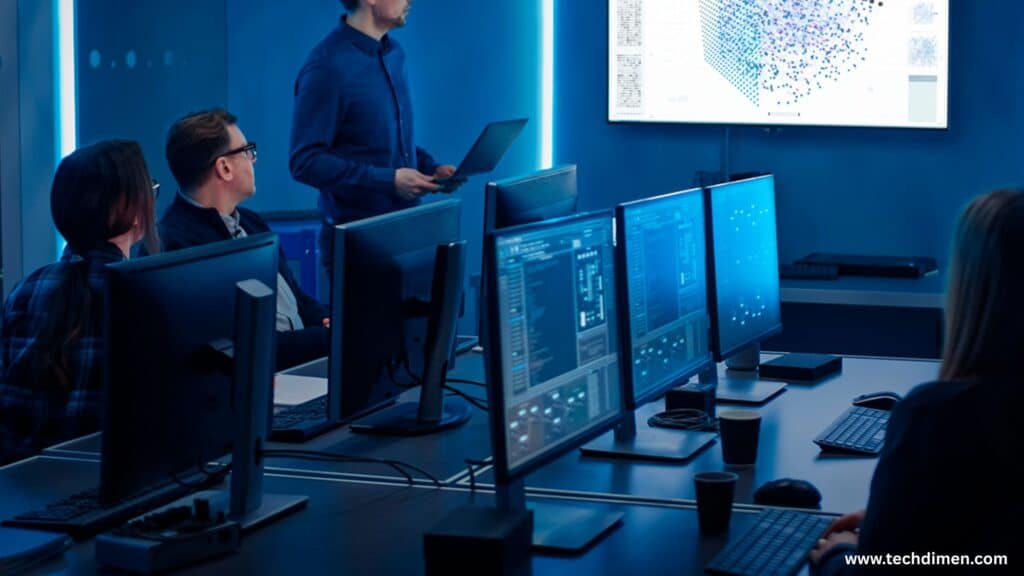Administrative office technology has become the invisible engine that powers modern organizations. As businesses evolve in an increasingly digital landscape, efficient office systems are no longer optional they’re essential. In this guide, you’ll learn exactly what administrative office technology is, why it matters, what tools are considered vital, and what the future holds.
What is Administrative Office Technology
Administrative office technology refers to the tools, systems, and digital platforms that help manage routine office tasks. This includes software for document creation, communication platforms, data storage systems, scheduling applications, and financial management tools. These technologies are crucial for supporting decision-making, improving workflow, and enhancing overall productivity.
The Shift from Traditional to Digital Office Solutions

Office environments have changed dramatically. Paper files, landline phones, and filing cabinets have been replaced by cloud storage, instant messaging platforms, and automated scheduling. This digital shift enables remote work, faster communication, and better data security. It also allows teams to collaborate in real time, even from different continents.
Modern Communication Systems in Office Technology
Communication tools are among the most critical components of administrative office technology. Modern offices rely on email platforms for formal communication and instant messaging apps for quick, informal updates. Video conferencing software has become the standard for remote meetings, while VoIP systems have replaced traditional landlines in many offices.
Document and Data Management in the Digital Office
Data is the backbone of every organization. Document management systems help businesses store, retrieve, and share files securely. Cloud storage solutions have minimized the need for physical storage. E signature tools have replaced the need for printing and scanning, allowing for faster approval processes. Automated document generation tools can create templates that save hours of repetitive work.
Scheduling, Task Management, and Workflow Optimization
Administrative professionals use digital calendars to coordinate meetings, track tasks, and set deadlines. Project management platforms allow for real time tracking of project progress and task assignment. Time tracking software ensures that employee productivity is measured accurately and resources are allocated efficiently.
Financial and Human Resource Technology

Financial management tools simplify payroll, accounting, and expense tracking. Administrative professionals can generate invoices, monitor budgets, and process employee reimbursements without spreadsheets. Human resources systems streamline employee onboarding, benefits administration, and performance reviews, making HR more efficient and data driven.
Cybersecurity and Compliance Tools
With growing threats to data privacy, cybersecurity has become a key focus. Encryption tools protect sensitive documents. Access control systems limit who can view or edit files. Compliance management software ensures that companies meet regulatory standards such as GDPR, HIPAA, or industry-specific requirements. These tools protect the organization from data breaches and legal penalties.
Challenges of Adopting New Technology in the Office
Despite its many advantages, not every organization embraces administrative office technology easily. One common challenge is resistance to change. Employees comfortable with legacy systems often hesitate to adopt new tools. Budget constraints can also slow adoption, especially in smaller businesses. Additionally, poor training results in tools being underused or misused. Integration issues with older systems create further complications.
How to Implement Office Technology Effectively

A successful technology rollout starts with evaluating your current workflows and identifying inefficiencies. Engage your team in the decision making process. Choose user friendly tools that are compatible with existing systems. Start small by piloting the new technology in one department before expanding it organization wide. Offer training sessions, create easy to follow guides, and provide ongoing support. Encourage feedback and be ready to adjust based on what your team needs.
Trends Shaping the Future of Office Technology
Artificial intelligence is already transforming the workplace. Virtual assistants can schedule meetings, transcribe conversations, and generate reports. No code platforms empower non technical users to create apps tailored to their workflow. Cloud based office environments allow for real time collaboration across borders. Mobile applications make it possible to manage administrative tasks from smartphones. Sustainable technologies are gaining popularity as companies strive to reduce their environmental impact.
Real-World Case Study: Streamlining Documents with Cloud Technology
XYZ Corporation faced recurring delays due to manual document handling. The company switched to a cloud based document management system, which allowed employees to upload, share, and access documents in real time. Within six months, document retrieval time dropped by 60 percent, and printing costs were reduced by nearly half. The new system also improved collaboration across departments, leading to faster project completion times.
Practical Strategies to Keep Up with Administrative Office Trends
Stay current by subscribing to newsletters focused on office technology trends. Join online communities where professionals share software reviews and productivity hacks. Attend webinars and training sessions hosted by software providers. Consider pursuing certifications in office management systems or digital administration tools to enhance your skillset.
Absolutely! Here’s a more detailed and expanded FAQ section with additional headings and varied wording, keeping it natural and rich with relevant keywords:
Certainly! Here’s a detailed explanation about Additional Resources for Office Technology with clear headings and expanded content:
Additional Resources for Office Technology
In modern workplaces, office technology plays a crucial role in enhancing productivity, communication, and overall efficiency. Beyond the basic hardware and software commonly used, there are numerous additional resources available that support and improve office technology infrastructure. These resources provide organizations with tools, knowledge, and support to optimize their technological environment.
Training and Educational Materials

One important additional resource is training and educational materials. Employees need to stay updated with the latest technological tools and software applications to maximize their effectiveness. Training programs, online tutorials, webinars, and workshops can provide essential knowledge on using office technology efficiently. These resources help in reducing errors, improving workflow, and increasing the overall comfort level with new systems.
Technical Support Services
Technical support services form another key resource. These include help desks, IT support teams, and outsourced technical assistance that help resolve hardware or software issues promptly. Having access to reliable technical support minimizes downtime and ensures that office technology functions smoothly without prolonged disruptions. Support can be available through phone, chat, or in-person visits, depending on the complexity of the problem.
Software and Applications
In addition to standard office suites, there are specialized software tools and applications that complement office technology. These might include project management platforms, communication apps, cloud storage solutions, and data analytics tools. Such software helps streamline collaboration, manage resources effectively, and facilitate remote work, which is increasingly important in modern office environments.
Hardware Upgrades and Accessories
Additional resources also include hardware upgrades and accessories that enhance the usability and performance of office technology. These can range from high quality monitors, ergonomic keyboards and mice, to docking stations and external storage devices. Investing in proper hardware ensures that employees can work comfortably and efficiently, reducing strain and improving output.
Networking and Connectivity Solutions

A robust network infrastructure is fundamental to office technology. Additional resources here include high speed internet connections, wireless access points, secure VPNs, and network management tools. These ensure that data flows seamlessly and securely between devices and locations, supporting both local and remote work setups.
Security Tools and Protocols
With the rise of cyber threats, office technology resources must include strong security measures. This encompasses antivirus software, firewalls, encryption tools, and multi factor authentication systems. Furthermore, cybersecurity training for employees is critical to prevent data breaches and protect sensitive information.
Documentation and Knowledge Bases
Lastly, comprehensive documentation and knowledge bases serve as valuable resources for office technology users. These contain manuals, troubleshooting guides, FAQs, and best practices. Easy access to this information empowers employees to solve common problems independently and reduces reliance on direct support.
By utilizing these additional resources, organizations can ensure their office technology infrastructure is not only well equipped but also well supported, enabling a smooth and productive working environment.
Would you like me to provide examples of specific tools or resources in any of these categories?
FAQ’s
What Does Administrative Office Technology Include?
Administrative office technology covers a broad range of digital tools and systems designed to support everyday office functions. This includes everything from office productivity software and document management systems to communication platforms and scheduling tools that enhance workflow efficiency.
Why Should Businesses Invest in Modern Office Technology Systems?
Investing in modern office equipment and software helps businesses streamline operations, minimize errors, and accelerate decision making. It enables teams to collaborate effectively, securely store data, and manage tasks efficiently, ultimately boosting overall productivity.
Which Tools Are Essential in Today’s Administrative Office Technology?
Essential tools typically include email platforms, team messaging apps, video conferencing software, cloud storage services, task management software, payroll and human resource management systems, and cybersecurity solutions. These core components form the backbone of a digitally enabled office.
How Can Companies Successfully Implement New Office Technology?
Smooth adoption of new office technology requires clear communication about benefits, inclusive training programs, and incremental rollout plans. Encouraging feedback and providing continuous support helps employees embrace change and reduces resistance.
What Are the Latest Trends in Office Automation and Technology?
Current trends emphasize AI powered virtual assistants, cloud based platforms, mobile office applications, IoT-enabled smart office devices, and no code workflow automation tools. These innovations aim to make office environments smarter and more adaptable.
How Does Cloud Storage Enhance Office Technology Integration?
Cloud storage solutions offer secure, scalable access to documents and data from any location, facilitating real time collaboration. This flexibility supports remote work and improves disaster recovery, while reducing reliance on physical hardware.
Are Administrative Office Technology Solutions Affordable for Small Businesses?
Yes, many providers offer scalable pricing models, including subscription based services that fit small to mid sized budgets. Cloud based tools and SaaS platforms reduce upfront costs, making advanced technology accessible to businesses of all sizes.
What Security Measures Are Built into Administrative Office Technology?
Security features often include data encryption, multi factor authentication, access control systems, and compliance management software that help protect sensitive information and ensure adherence to regulations like GDPR and HIPAA.
Can Administrative Office Technology Support Remote and Hybrid Work Models?
Absolutely. Tools such as unified communications platforms, virtual meeting software, and cloud based project management systems enable teams to work together seamlessly regardless of physical location.
Where Can Professionals Find Training and Certification in Office Technology?
Numerous online platforms provide courses, tutorials, and certifications for office productivity software, project management tools, and cybersecurity fundamentals. Participating in webinars, workshops, and e learning modules can enhance your administrative technology skills.
How Does Task Management Software Improve Office Productivity?
Task management applications help prioritize assignments, track progress, and facilitate team collaboration. They reduce missed deadlines and improve workflow transparency, allowing managers to allocate resources more effectively.
What Role Does AI Play in Administrative Office Technology?
AI driven tools automate repetitive tasks, assist with scheduling, analyze data for better decision making, and even handle customer queries. This reduces manual workload and allows administrative staff to focus on more strategic activities.
Final Thoughts on Embracing Office Technology
Administrative office technology is not just a trend it’s a necessity. Embracing modern tools improves productivity, enhances communication, and strengthens data security. Businesses that invest in upgrading their administrative systems gain a significant competitive advantage. The future belongs to those who are agile, well equipped, and open to continuous innovation.

Jhon AJS is a tech enthusiast and author at Tech Dimen, where he explores the latest trends in technology and TV dimensions. With a passion for simplifying complex topics, Jhon aims to make tech accessible and engaging for readers of all levels.







